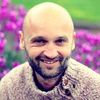This is a picture of Friar's stall at an arts and craft fair I helped to organize, as part of my M.Sc dissertation - The art and science of organization. It was a deliberate attempt to experience and document the flow of emergence by providing enough flexibility for something novel to happen, whilst being rigorous enough to meet academic standards. In the resilience jargon it is called freedom and constraint, although 'governance bandwidth' is a better term in the context of organizational change.
In terms of a dissertation, it was quite uncertain what the outcome would be and whether or not it would be deemed successful by academic and my own standards of governance. That was the deep uncertainty part. Could I commit to something new without being derailed by worry and reverting to old habits? Would I end up being a failure or too cocksure from success?
I am glad to say it passed, however upon reflection and after setting up my own consultancy it points clearly to the core ambiguity that many organizations face: the need for adaptation and novelty pitched against the desire for control in the face of uncertainty and high personal stakes.
It is not easy to strike the right balance between freedom and control, especially when the governance bandwidth and the experience of using the tools for managing the process are not already in place. The move into taking different types of risk (that is to say doing and saying things differently) is cloudier when the future seems to be getting 'hyperbolically' uncertain.
It is often easier to stay in the comfort zone, as it feels safe. The paradox being that the comfort zone runs the risk of leaving an individual, division or whole organization stranded when life moves on. This is a well-known model of behavior and coaches advise on stretching the comfort zone to grow the 'uncertainty muscle' to help feeling uncomfortable without adversely reacting or reverting to old 'feel-safe' habits.
One way of exercising the uncertainty muscle is to visualize different versions of the future. In strategic consultancy it is called scenario planning. In one of my old companies we used to do something similar in 'off-sites' in order to plan for difficult markets and it was somewhat akin to a fire drill. In hindsight, we were well ahead of the curve as the management team recognized the value of creating space for this exercise (it is standard operating procedure for infrastructure assets although not so much for intellectual capital).
Unfortunately, we did not quite have the facilitation and methodological experience to make the most of a great idea and were still left groping in the dark. This was especially true of how to coax a variety of opinions and work with multiple scenarios and a diverse set of personalities, which is the art of organization. The science is to make 'the groping in the dark' into a reusable experience and process fit for many different purposes and outcomes. The art and the science of organization is therefore to facilitate the process of adaption.
In business this has multiple uses, ranging from designing new products and services to re-imagining the customer journey or even asking about core purpose. There are many professional practices that facilitate the skill of becoming familiar with uncertainty and getting the right balance between freedom and constraint.
This is fundamental to business in today's highly innovative and disruptive world. Importantly, it can take a fear of uncertainty into the mindset of adaptability rather than control - possibly the most valuable asset in any company's culture or individuals way of being.
